Introduction to Financial Accounting: Journal Entries, Trial Balance, Accruals, Cost Concept, Matching Principle, and More
VerifiedAdded on 2023/04/23
|12
|1898
|450
AI Summary
This document provides an introduction to financial accounting concepts such as accruals, cost concept, matching principle, and more. It includes journal entries, trial balance, adjusting entries, profit and loss account, balance sheet, and references. The document also explains the importance of recognizing revenue and expenses in the appropriate reporting period, regardless of the timing of cash flows.
Contribute Materials
Your contribution can guide someone’s learning journey. Share your
documents today.

Introduction to financial accounting
Secure Best Marks with AI Grader
Need help grading? Try our AI Grader for instant feedback on your assignments.
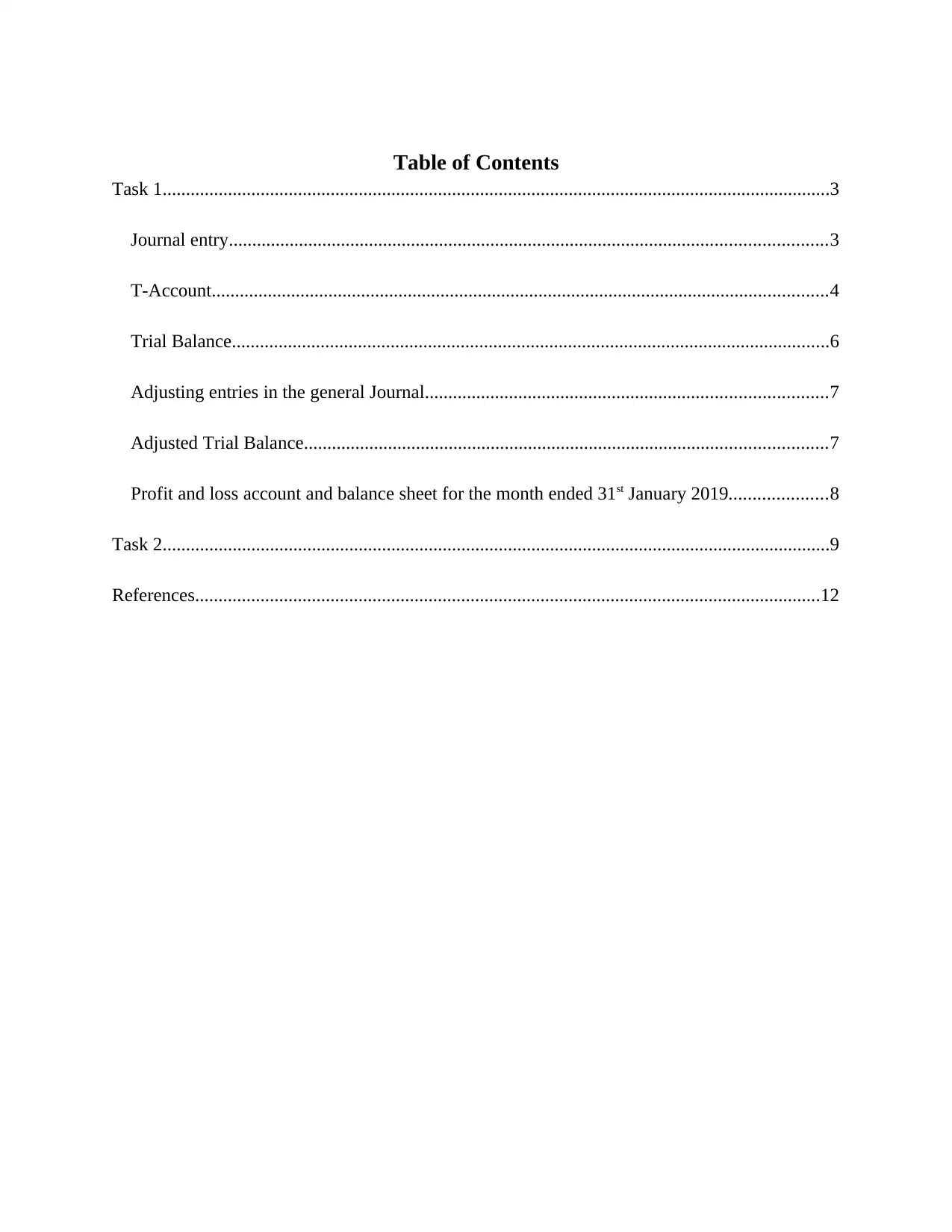
Table of Contents
Task 1...............................................................................................................................................3
Journal entry................................................................................................................................3
T-Account....................................................................................................................................4
Trial Balance................................................................................................................................6
Adjusting entries in the general Journal......................................................................................7
Adjusted Trial Balance................................................................................................................7
Profit and loss account and balance sheet for the month ended 31st January 2019.....................8
Task 2...............................................................................................................................................9
References......................................................................................................................................12
Task 1...............................................................................................................................................3
Journal entry................................................................................................................................3
T-Account....................................................................................................................................4
Trial Balance................................................................................................................................6
Adjusting entries in the general Journal......................................................................................7
Adjusted Trial Balance................................................................................................................7
Profit and loss account and balance sheet for the month ended 31st January 2019.....................8
Task 2...............................................................................................................................................9
References......................................................................................................................................12
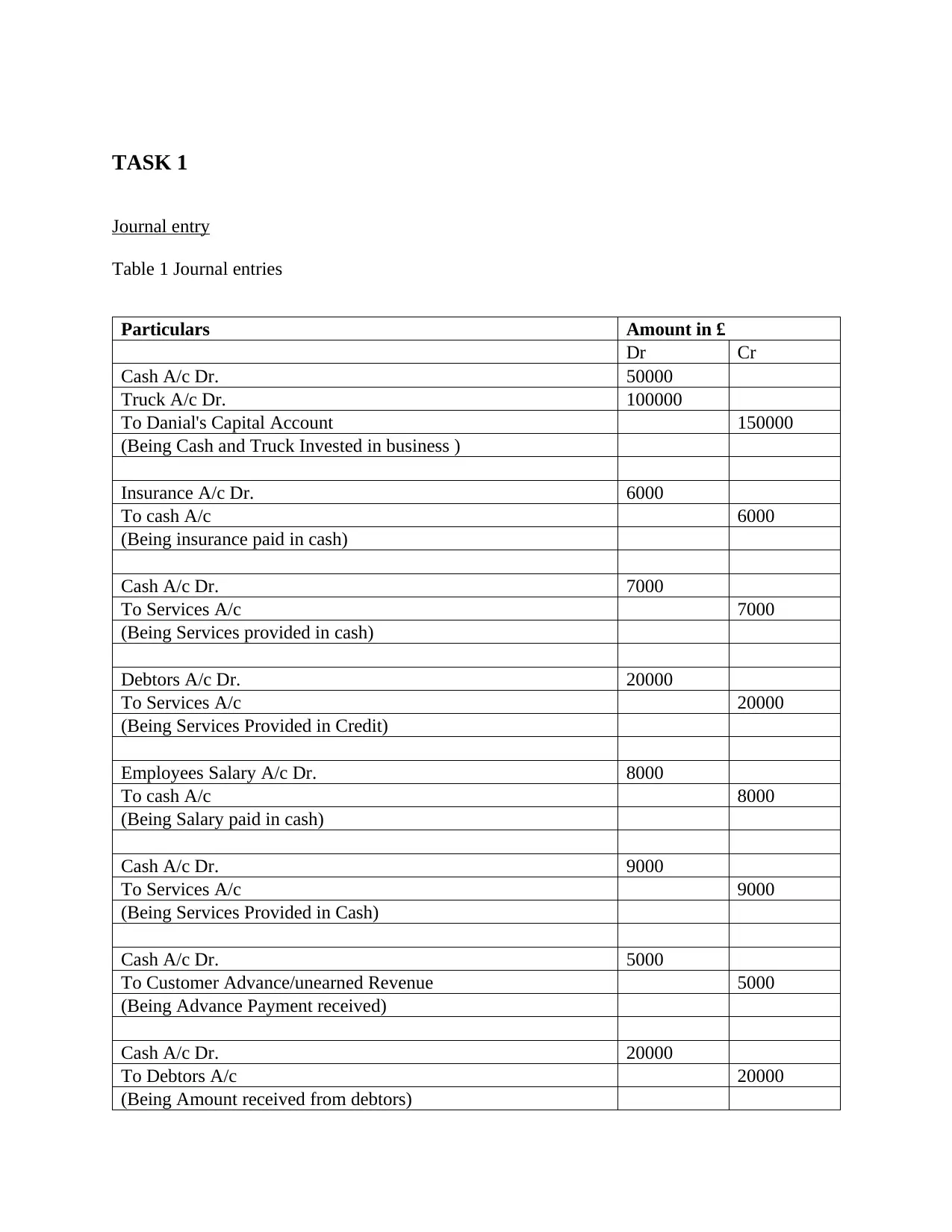
TASK 1
Journal entry
Table 1 Journal entries
Particulars Amount in £
Dr Cr
Cash A/c Dr. 50000
Truck A/c Dr. 100000
To Danial's Capital Account 150000
(Being Cash and Truck Invested in business )
Insurance A/c Dr. 6000
To cash A/c 6000
(Being insurance paid in cash)
Cash A/c Dr. 7000
To Services A/c 7000
(Being Services provided in cash)
Debtors A/c Dr. 20000
To Services A/c 20000
(Being Services Provided in Credit)
Employees Salary A/c Dr. 8000
To cash A/c 8000
(Being Salary paid in cash)
Cash A/c Dr. 9000
To Services A/c 9000
(Being Services Provided in Cash)
Cash A/c Dr. 5000
To Customer Advance/unearned Revenue 5000
(Being Advance Payment received)
Cash A/c Dr. 20000
To Debtors A/c 20000
(Being Amount received from debtors)
Journal entry
Table 1 Journal entries
Particulars Amount in £
Dr Cr
Cash A/c Dr. 50000
Truck A/c Dr. 100000
To Danial's Capital Account 150000
(Being Cash and Truck Invested in business )
Insurance A/c Dr. 6000
To cash A/c 6000
(Being insurance paid in cash)
Cash A/c Dr. 7000
To Services A/c 7000
(Being Services provided in cash)
Debtors A/c Dr. 20000
To Services A/c 20000
(Being Services Provided in Credit)
Employees Salary A/c Dr. 8000
To cash A/c 8000
(Being Salary paid in cash)
Cash A/c Dr. 9000
To Services A/c 9000
(Being Services Provided in Cash)
Cash A/c Dr. 5000
To Customer Advance/unearned Revenue 5000
(Being Advance Payment received)
Cash A/c Dr. 20000
To Debtors A/c 20000
(Being Amount received from debtors)
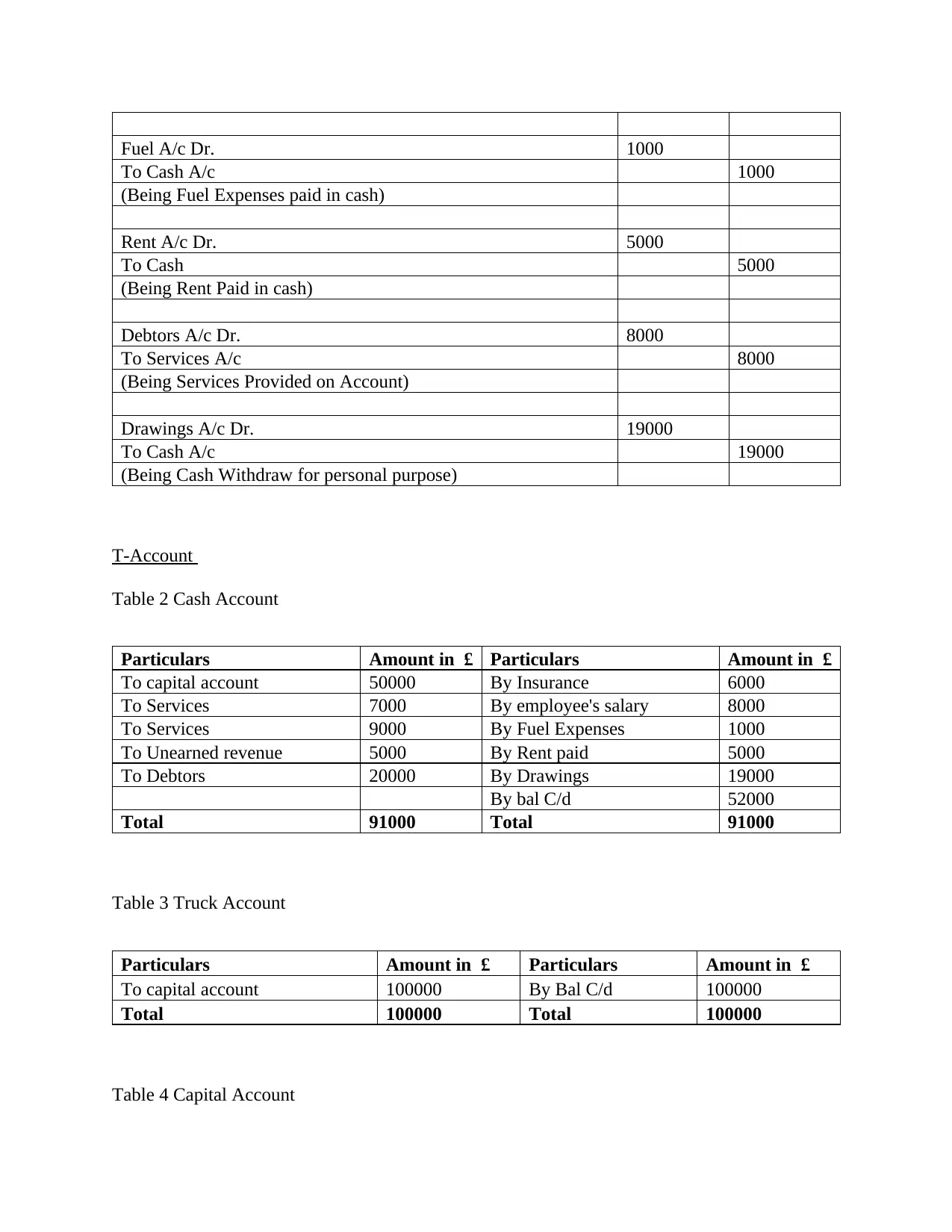
Fuel A/c Dr. 1000
To Cash A/c 1000
(Being Fuel Expenses paid in cash)
Rent A/c Dr. 5000
To Cash 5000
(Being Rent Paid in cash)
Debtors A/c Dr. 8000
To Services A/c 8000
(Being Services Provided on Account)
Drawings A/c Dr. 19000
To Cash A/c 19000
(Being Cash Withdraw for personal purpose)
T-Account
Table 2 Cash Account
Particulars Amount in £ Particulars Amount in £
To capital account 50000 By Insurance 6000
To Services 7000 By employee's salary 8000
To Services 9000 By Fuel Expenses 1000
To Unearned revenue 5000 By Rent paid 5000
To Debtors 20000 By Drawings 19000
By bal C/d 52000
Total 91000 Total 91000
Table 3 Truck Account
Particulars Amount in £ Particulars Amount in £
To capital account 100000 By Bal C/d 100000
Total 100000 Total 100000
Table 4 Capital Account
To Cash A/c 1000
(Being Fuel Expenses paid in cash)
Rent A/c Dr. 5000
To Cash 5000
(Being Rent Paid in cash)
Debtors A/c Dr. 8000
To Services A/c 8000
(Being Services Provided on Account)
Drawings A/c Dr. 19000
To Cash A/c 19000
(Being Cash Withdraw for personal purpose)
T-Account
Table 2 Cash Account
Particulars Amount in £ Particulars Amount in £
To capital account 50000 By Insurance 6000
To Services 7000 By employee's salary 8000
To Services 9000 By Fuel Expenses 1000
To Unearned revenue 5000 By Rent paid 5000
To Debtors 20000 By Drawings 19000
By bal C/d 52000
Total 91000 Total 91000
Table 3 Truck Account
Particulars Amount in £ Particulars Amount in £
To capital account 100000 By Bal C/d 100000
Total 100000 Total 100000
Table 4 Capital Account
Secure Best Marks with AI Grader
Need help grading? Try our AI Grader for instant feedback on your assignments.
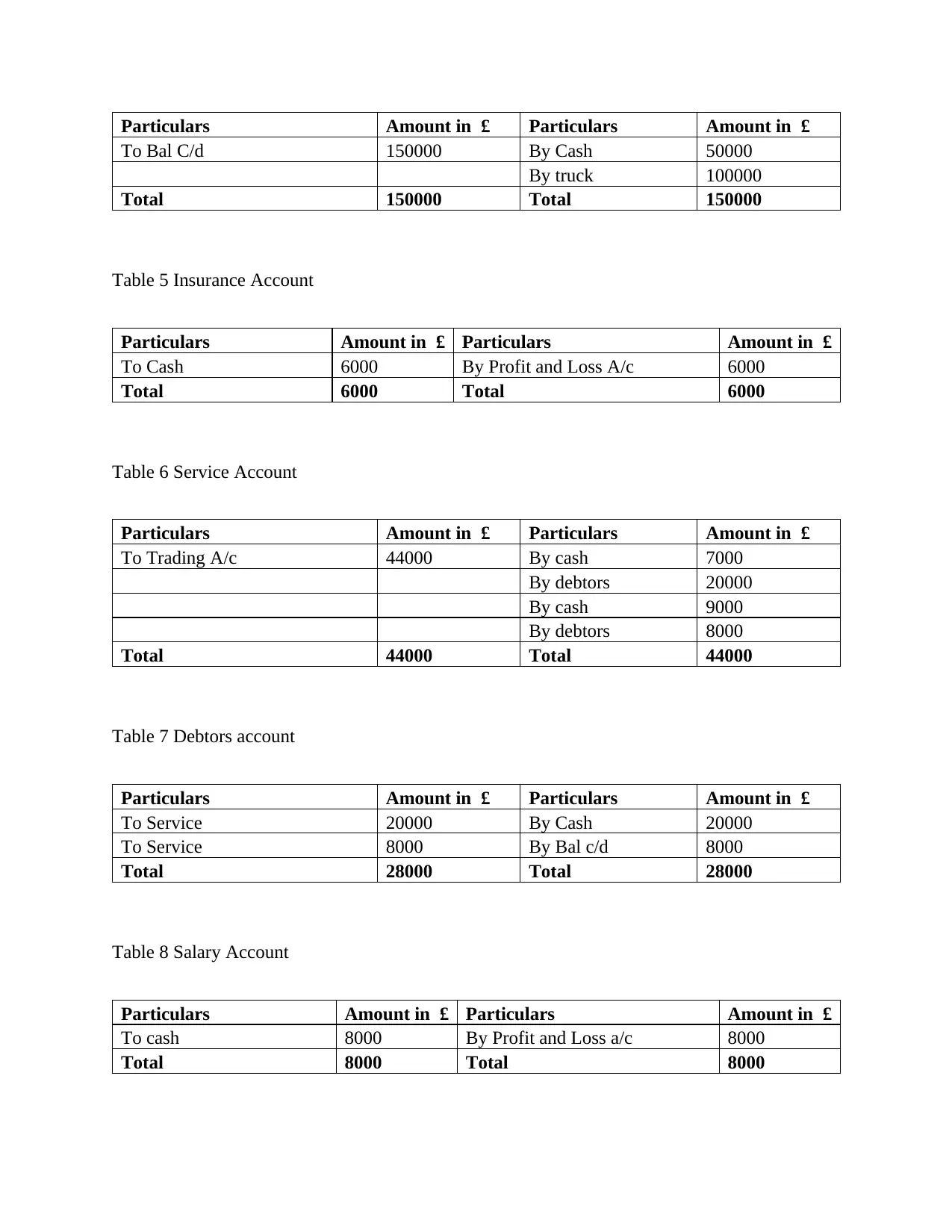
Particulars Amount in £ Particulars Amount in £
To Bal C/d 150000 By Cash 50000
By truck 100000
Total 150000 Total 150000
Table 5 Insurance Account
Particulars Amount in £ Particulars Amount in £
To Cash 6000 By Profit and Loss A/c 6000
Total 6000 Total 6000
Table 6 Service Account
Particulars Amount in £ Particulars Amount in £
To Trading A/c 44000 By cash 7000
By debtors 20000
By cash 9000
By debtors 8000
Total 44000 Total 44000
Table 7 Debtors account
Particulars Amount in £ Particulars Amount in £
To Service 20000 By Cash 20000
To Service 8000 By Bal c/d 8000
Total 28000 Total 28000
Table 8 Salary Account
Particulars Amount in £ Particulars Amount in £
To cash 8000 By Profit and Loss a/c 8000
Total 8000 Total 8000
To Bal C/d 150000 By Cash 50000
By truck 100000
Total 150000 Total 150000
Table 5 Insurance Account
Particulars Amount in £ Particulars Amount in £
To Cash 6000 By Profit and Loss A/c 6000
Total 6000 Total 6000
Table 6 Service Account
Particulars Amount in £ Particulars Amount in £
To Trading A/c 44000 By cash 7000
By debtors 20000
By cash 9000
By debtors 8000
Total 44000 Total 44000
Table 7 Debtors account
Particulars Amount in £ Particulars Amount in £
To Service 20000 By Cash 20000
To Service 8000 By Bal c/d 8000
Total 28000 Total 28000
Table 8 Salary Account
Particulars Amount in £ Particulars Amount in £
To cash 8000 By Profit and Loss a/c 8000
Total 8000 Total 8000
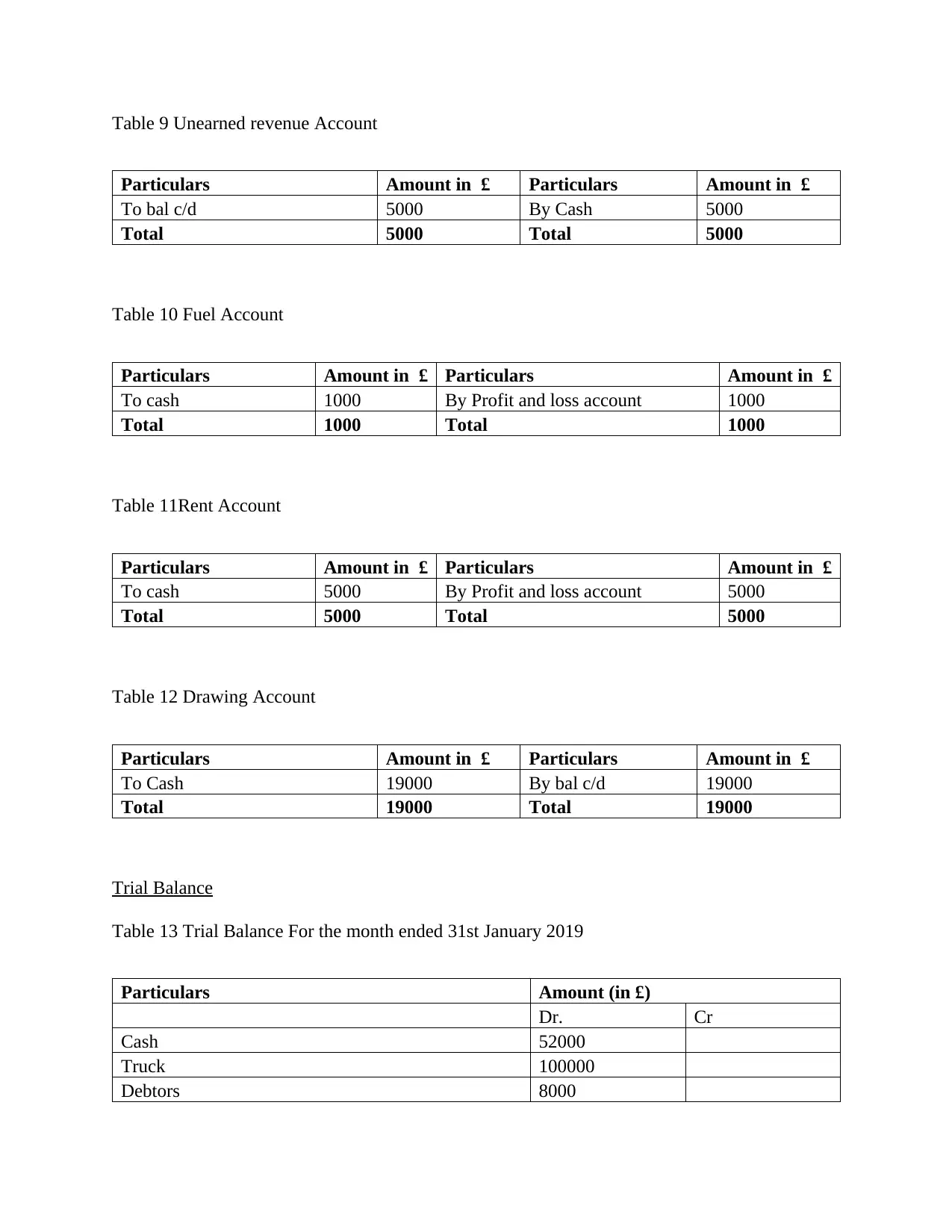
Table 9 Unearned revenue Account
Particulars Amount in £ Particulars Amount in £
To bal c/d 5000 By Cash 5000
Total 5000 Total 5000
Table 10 Fuel Account
Particulars Amount in £ Particulars Amount in £
To cash 1000 By Profit and loss account 1000
Total 1000 Total 1000
Table 11Rent Account
Particulars Amount in £ Particulars Amount in £
To cash 5000 By Profit and loss account 5000
Total 5000 Total 5000
Table 12 Drawing Account
Particulars Amount in £ Particulars Amount in £
To Cash 19000 By bal c/d 19000
Total 19000 Total 19000
Trial Balance
Table 13 Trial Balance For the month ended 31st January 2019
Particulars Amount (in £)
Dr. Cr
Cash 52000
Truck 100000
Debtors 8000
Particulars Amount in £ Particulars Amount in £
To bal c/d 5000 By Cash 5000
Total 5000 Total 5000
Table 10 Fuel Account
Particulars Amount in £ Particulars Amount in £
To cash 1000 By Profit and loss account 1000
Total 1000 Total 1000
Table 11Rent Account
Particulars Amount in £ Particulars Amount in £
To cash 5000 By Profit and loss account 5000
Total 5000 Total 5000
Table 12 Drawing Account
Particulars Amount in £ Particulars Amount in £
To Cash 19000 By bal c/d 19000
Total 19000 Total 19000
Trial Balance
Table 13 Trial Balance For the month ended 31st January 2019
Particulars Amount (in £)
Dr. Cr
Cash 52000
Truck 100000
Debtors 8000
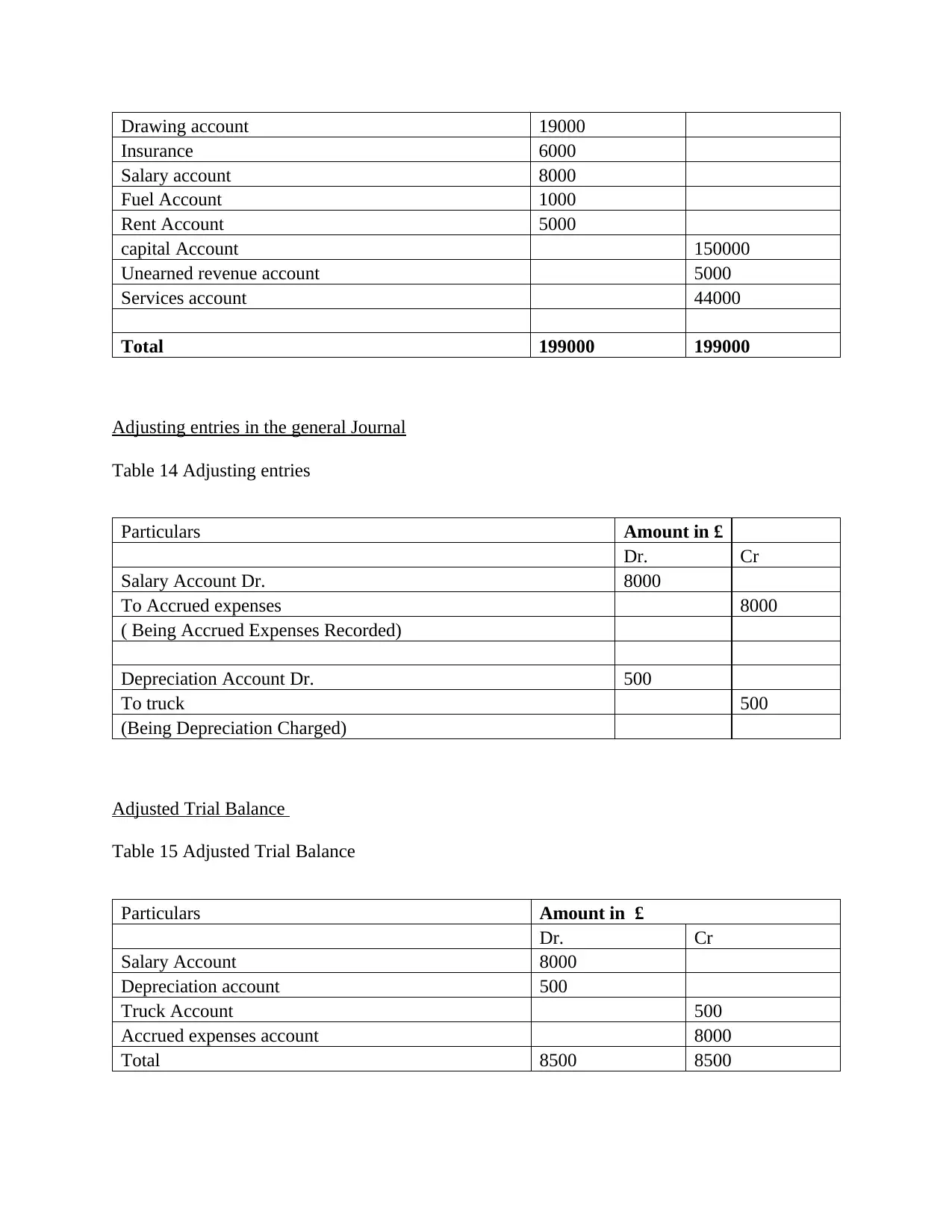
Drawing account 19000
Insurance 6000
Salary account 8000
Fuel Account 1000
Rent Account 5000
capital Account 150000
Unearned revenue account 5000
Services account 44000
Total 199000 199000
Adjusting entries in the general Journal
Table 14 Adjusting entries
Particulars Amount in £
Dr. Cr
Salary Account Dr. 8000
To Accrued expenses 8000
( Being Accrued Expenses Recorded)
Depreciation Account Dr. 500
To truck 500
(Being Depreciation Charged)
Adjusted Trial Balance
Table 15 Adjusted Trial Balance
Particulars Amount in £
Dr. Cr
Salary Account 8000
Depreciation account 500
Truck Account 500
Accrued expenses account 8000
Total 8500 8500
Insurance 6000
Salary account 8000
Fuel Account 1000
Rent Account 5000
capital Account 150000
Unearned revenue account 5000
Services account 44000
Total 199000 199000
Adjusting entries in the general Journal
Table 14 Adjusting entries
Particulars Amount in £
Dr. Cr
Salary Account Dr. 8000
To Accrued expenses 8000
( Being Accrued Expenses Recorded)
Depreciation Account Dr. 500
To truck 500
(Being Depreciation Charged)
Adjusted Trial Balance
Table 15 Adjusted Trial Balance
Particulars Amount in £
Dr. Cr
Salary Account 8000
Depreciation account 500
Truck Account 500
Accrued expenses account 8000
Total 8500 8500
Paraphrase This Document
Need a fresh take? Get an instant paraphrase of this document with our AI Paraphraser
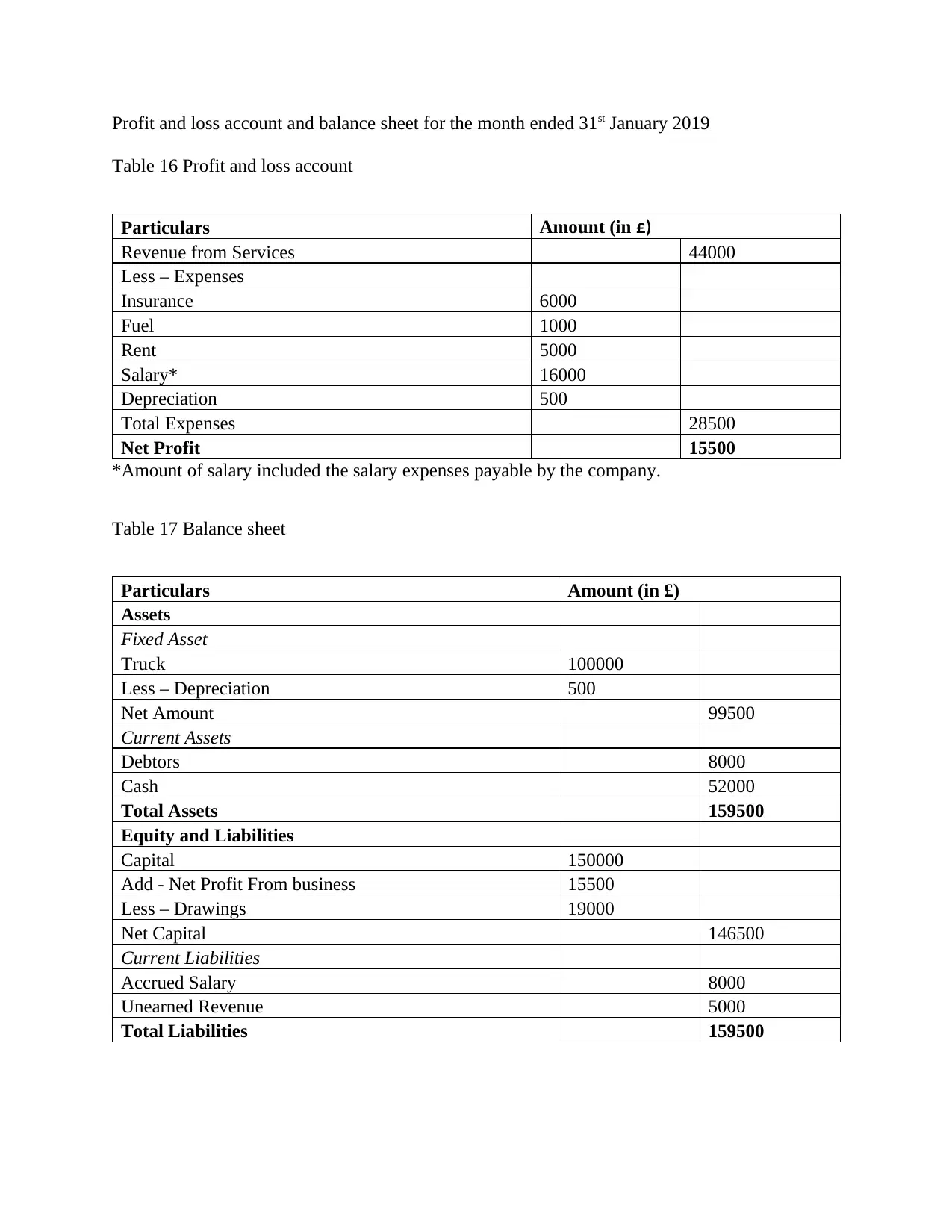
Profit and loss account and balance sheet for the month ended 31st January 2019
Table 16 Profit and loss account
Particulars Amount (in £)
Revenue from Services 44000
Less – Expenses
Insurance 6000
Fuel 1000
Rent 5000
Salary* 16000
Depreciation 500
Total Expenses 28500
Net Profit 15500
*Amount of salary included the salary expenses payable by the company.
Table 17 Balance sheet
Particulars Amount (in £)
Assets
Fixed Asset
Truck 100000
Less – Depreciation 500
Net Amount 99500
Current Assets
Debtors 8000
Cash 52000
Total Assets 159500
Equity and Liabilities
Capital 150000
Add - Net Profit From business 15500
Less – Drawings 19000
Net Capital 146500
Current Liabilities
Accrued Salary 8000
Unearned Revenue 5000
Total Liabilities 159500
Table 16 Profit and loss account
Particulars Amount (in £)
Revenue from Services 44000
Less – Expenses
Insurance 6000
Fuel 1000
Rent 5000
Salary* 16000
Depreciation 500
Total Expenses 28500
Net Profit 15500
*Amount of salary included the salary expenses payable by the company.
Table 17 Balance sheet
Particulars Amount (in £)
Assets
Fixed Asset
Truck 100000
Less – Depreciation 500
Net Amount 99500
Current Assets
Debtors 8000
Cash 52000
Total Assets 159500
Equity and Liabilities
Capital 150000
Add - Net Profit From business 15500
Less – Drawings 19000
Net Capital 146500
Current Liabilities
Accrued Salary 8000
Unearned Revenue 5000
Total Liabilities 159500
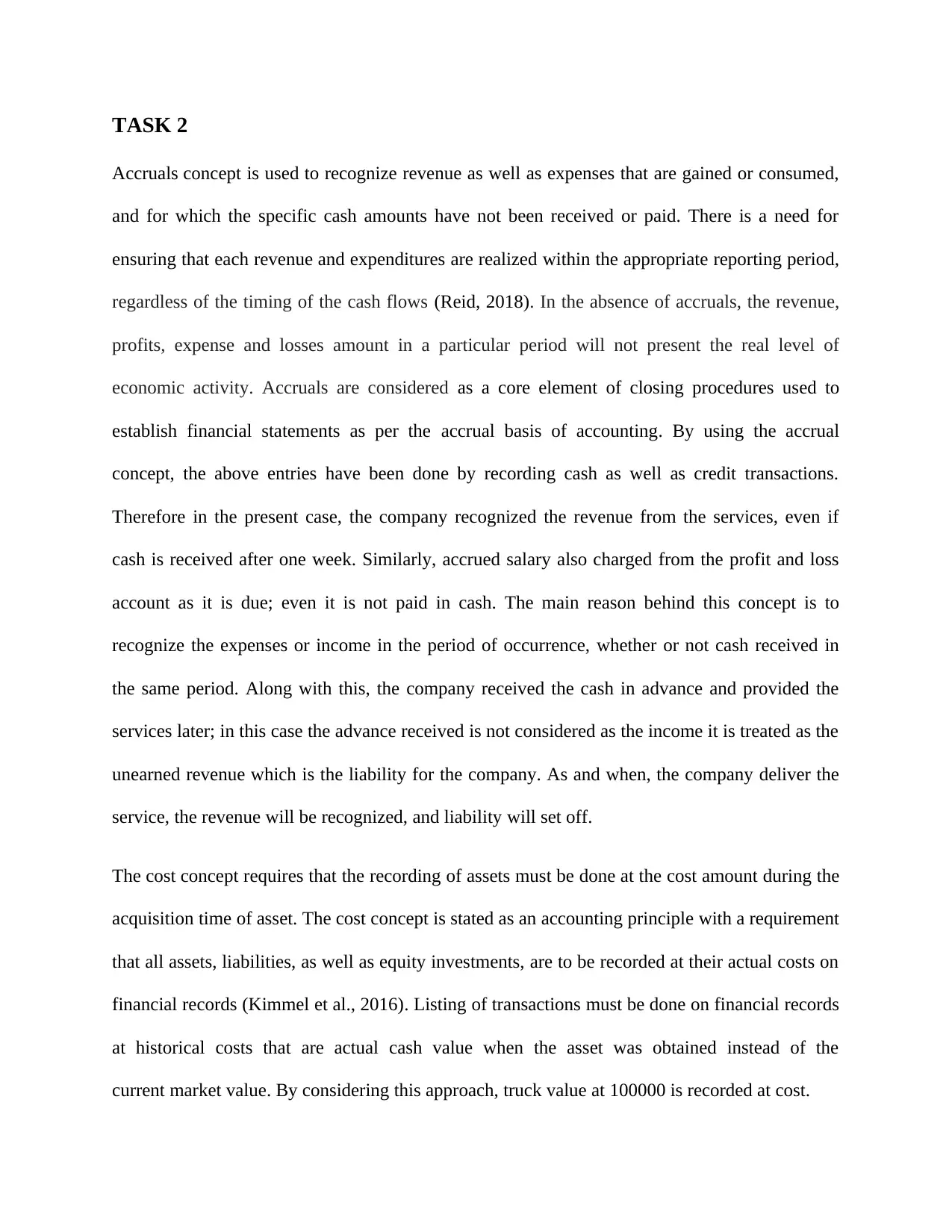
TASK 2
Accruals concept is used to recognize revenue as well as expenses that are gained or consumed,
and for which the specific cash amounts have not been received or paid. There is a need for
ensuring that each revenue and expenditures are realized within the appropriate reporting period,
regardless of the timing of the cash flows (Reid, 2018). In the absence of accruals, the revenue,
profits, expense and losses amount in a particular period will not present the real level of
economic activity. Accruals are considered as a core element of closing procedures used to
establish financial statements as per the accrual basis of accounting. By using the accrual
concept, the above entries have been done by recording cash as well as credit transactions.
Therefore in the present case, the company recognized the revenue from the services, even if
cash is received after one week. Similarly, accrued salary also charged from the profit and loss
account as it is due; even it is not paid in cash. The main reason behind this concept is to
recognize the expenses or income in the period of occurrence, whether or not cash received in
the same period. Along with this, the company received the cash in advance and provided the
services later; in this case the advance received is not considered as the income it is treated as the
unearned revenue which is the liability for the company. As and when, the company deliver the
service, the revenue will be recognized, and liability will set off.
The cost concept requires that the recording of assets must be done at the cost amount during the
acquisition time of asset. The cost concept is stated as an accounting principle with a requirement
that all assets, liabilities, as well as equity investments, are to be recorded at their actual costs on
financial records (Kimmel et al., 2016). Listing of transactions must be done on financial records
at historical costs that are actual cash value when the asset was obtained instead of the
current market value. By considering this approach, truck value at 100000 is recorded at cost.
Accruals concept is used to recognize revenue as well as expenses that are gained or consumed,
and for which the specific cash amounts have not been received or paid. There is a need for
ensuring that each revenue and expenditures are realized within the appropriate reporting period,
regardless of the timing of the cash flows (Reid, 2018). In the absence of accruals, the revenue,
profits, expense and losses amount in a particular period will not present the real level of
economic activity. Accruals are considered as a core element of closing procedures used to
establish financial statements as per the accrual basis of accounting. By using the accrual
concept, the above entries have been done by recording cash as well as credit transactions.
Therefore in the present case, the company recognized the revenue from the services, even if
cash is received after one week. Similarly, accrued salary also charged from the profit and loss
account as it is due; even it is not paid in cash. The main reason behind this concept is to
recognize the expenses or income in the period of occurrence, whether or not cash received in
the same period. Along with this, the company received the cash in advance and provided the
services later; in this case the advance received is not considered as the income it is treated as the
unearned revenue which is the liability for the company. As and when, the company deliver the
service, the revenue will be recognized, and liability will set off.
The cost concept requires that the recording of assets must be done at the cost amount during the
acquisition time of asset. The cost concept is stated as an accounting principle with a requirement
that all assets, liabilities, as well as equity investments, are to be recorded at their actual costs on
financial records (Kimmel et al., 2016). Listing of transactions must be done on financial records
at historical costs that are actual cash value when the asset was obtained instead of the
current market value. By considering this approach, truck value at 100000 is recorded at cost.
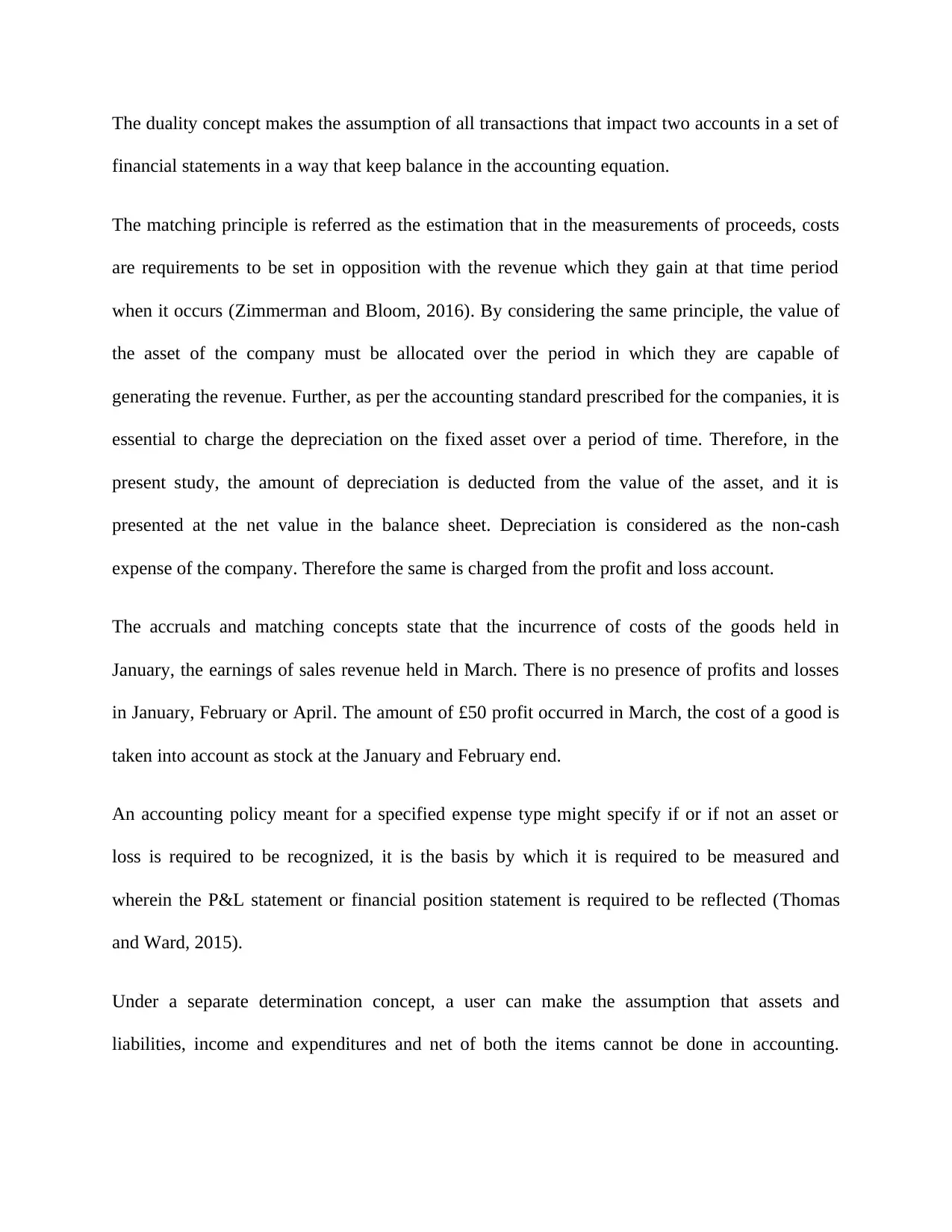
The duality concept makes the assumption of all transactions that impact two accounts in a set of
financial statements in a way that keep balance in the accounting equation.
The matching principle is referred as the estimation that in the measurements of proceeds, costs
are requirements to be set in opposition with the revenue which they gain at that time period
when it occurs (Zimmerman and Bloom, 2016). By considering the same principle, the value of
the asset of the company must be allocated over the period in which they are capable of
generating the revenue. Further, as per the accounting standard prescribed for the companies, it is
essential to charge the depreciation on the fixed asset over a period of time. Therefore, in the
present study, the amount of depreciation is deducted from the value of the asset, and it is
presented at the net value in the balance sheet. Depreciation is considered as the non-cash
expense of the company. Therefore the same is charged from the profit and loss account.
The accruals and matching concepts state that the incurrence of costs of the goods held in
January, the earnings of sales revenue held in March. There is no presence of profits and losses
in January, February or April. The amount of £50 profit occurred in March, the cost of a good is
taken into account as stock at the January and February end.
An accounting policy meant for a specified expense type might specify if or if not an asset or
loss is required to be recognized, it is the basis by which it is required to be measured and
wherein the P&L statement or financial position statement is required to be reflected (Thomas
and Ward, 2015).
Under a separate determination concept, a user can make the assumption that assets and
liabilities, income and expenditures and net of both the items cannot be done in accounting.
financial statements in a way that keep balance in the accounting equation.
The matching principle is referred as the estimation that in the measurements of proceeds, costs
are requirements to be set in opposition with the revenue which they gain at that time period
when it occurs (Zimmerman and Bloom, 2016). By considering the same principle, the value of
the asset of the company must be allocated over the period in which they are capable of
generating the revenue. Further, as per the accounting standard prescribed for the companies, it is
essential to charge the depreciation on the fixed asset over a period of time. Therefore, in the
present study, the amount of depreciation is deducted from the value of the asset, and it is
presented at the net value in the balance sheet. Depreciation is considered as the non-cash
expense of the company. Therefore the same is charged from the profit and loss account.
The accruals and matching concepts state that the incurrence of costs of the goods held in
January, the earnings of sales revenue held in March. There is no presence of profits and losses
in January, February or April. The amount of £50 profit occurred in March, the cost of a good is
taken into account as stock at the January and February end.
An accounting policy meant for a specified expense type might specify if or if not an asset or
loss is required to be recognized, it is the basis by which it is required to be measured and
wherein the P&L statement or financial position statement is required to be reflected (Thomas
and Ward, 2015).
Under a separate determination concept, a user can make the assumption that assets and
liabilities, income and expenditures and net of both the items cannot be done in accounting.
Secure Best Marks with AI Grader
Need help grading? Try our AI Grader for instant feedback on your assignments.
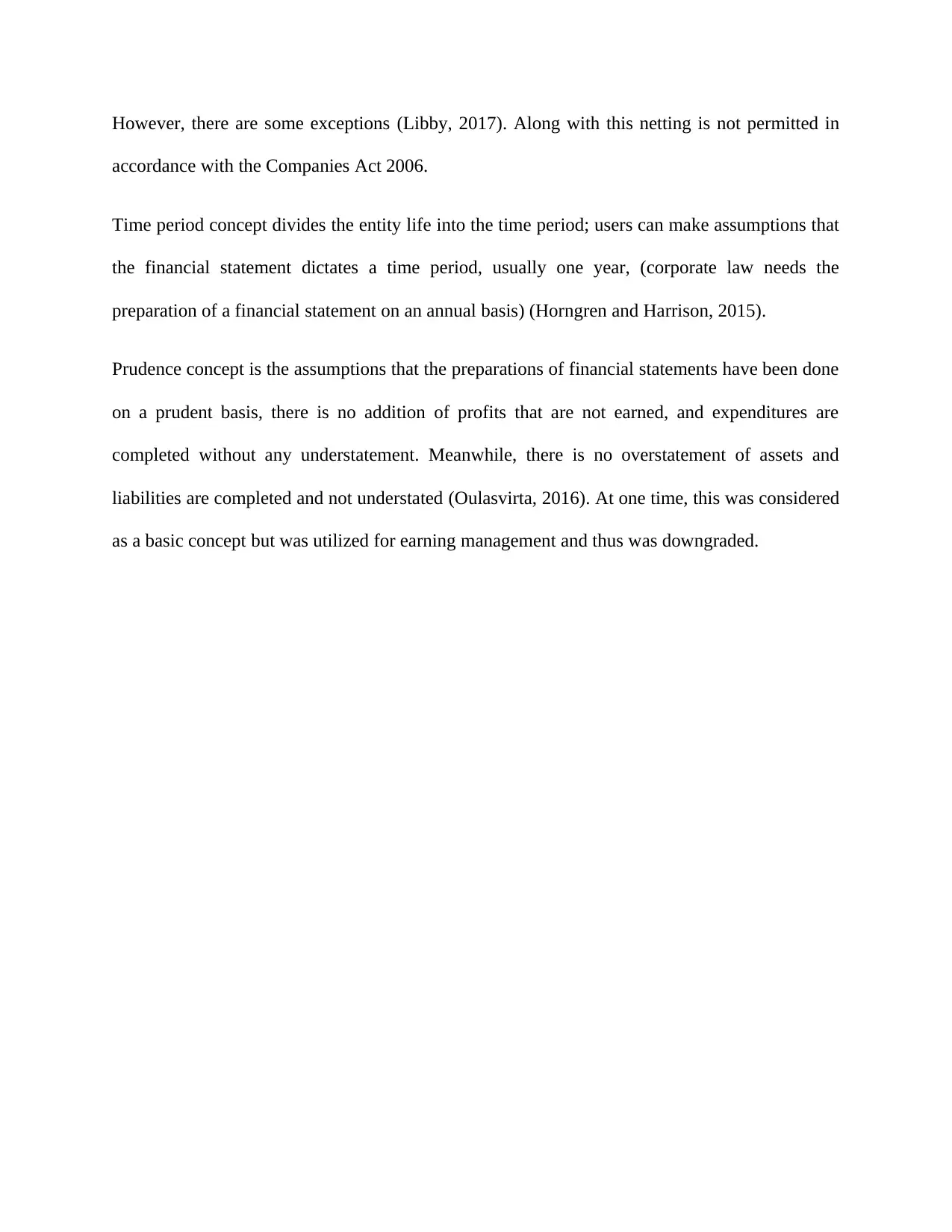
However, there are some exceptions (Libby, 2017). Along with this netting is not permitted in
accordance with the Companies Act 2006.
Time period concept divides the entity life into the time period; users can make assumptions that
the financial statement dictates a time period, usually one year, (corporate law needs the
preparation of a financial statement on an annual basis) (Horngren and Harrison, 2015).
Prudence concept is the assumptions that the preparations of financial statements have been done
on a prudent basis, there is no addition of profits that are not earned, and expenditures are
completed without any understatement. Meanwhile, there is no overstatement of assets and
liabilities are completed and not understated (Oulasvirta, 2016). At one time, this was considered
as a basic concept but was utilized for earning management and thus was downgraded.
accordance with the Companies Act 2006.
Time period concept divides the entity life into the time period; users can make assumptions that
the financial statement dictates a time period, usually one year, (corporate law needs the
preparation of a financial statement on an annual basis) (Horngren and Harrison, 2015).
Prudence concept is the assumptions that the preparations of financial statements have been done
on a prudent basis, there is no addition of profits that are not earned, and expenditures are
completed without any understatement. Meanwhile, there is no overstatement of assets and
liabilities are completed and not understated (Oulasvirta, 2016). At one time, this was considered
as a basic concept but was utilized for earning management and thus was downgraded.
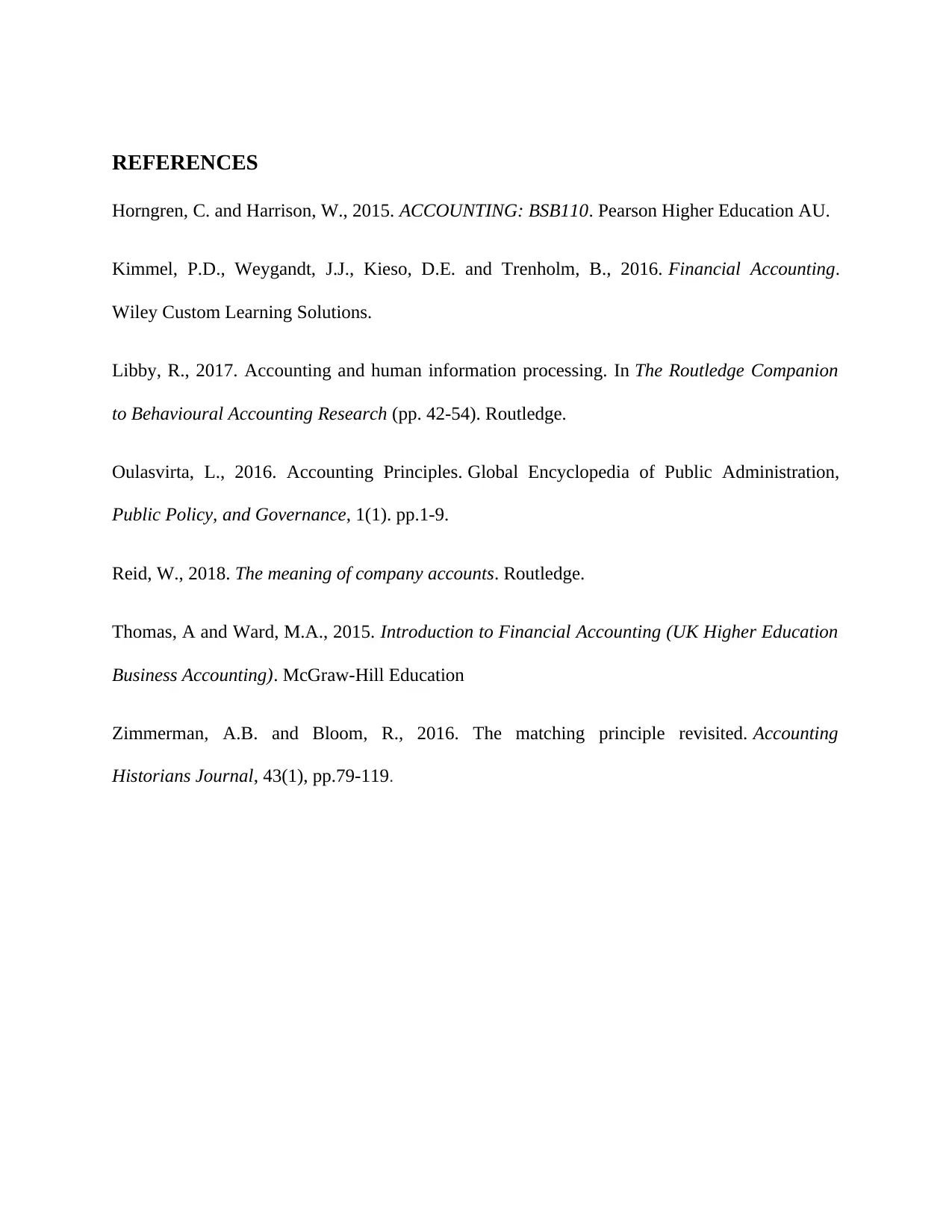
REFERENCES
Horngren, C. and Harrison, W., 2015. ACCOUNTING: BSB110. Pearson Higher Education AU.
Kimmel, P.D., Weygandt, J.J., Kieso, D.E. and Trenholm, B., 2016. Financial Accounting.
Wiley Custom Learning Solutions.
Libby, R., 2017. Accounting and human information processing. In The Routledge Companion
to Behavioural Accounting Research (pp. 42-54). Routledge.
Oulasvirta, L., 2016. Accounting Principles. Global Encyclopedia of Public Administration,
Public Policy, and Governance, 1(1). pp.1-9.
Reid, W., 2018. The meaning of company accounts. Routledge.
Thomas, A and Ward, M.A., 2015. Introduction to Financial Accounting (UK Higher Education
Business Accounting). McGraw-Hill Education
Zimmerman, A.B. and Bloom, R., 2016. The matching principle revisited. Accounting
Historians Journal, 43(1), pp.79-119.
Horngren, C. and Harrison, W., 2015. ACCOUNTING: BSB110. Pearson Higher Education AU.
Kimmel, P.D., Weygandt, J.J., Kieso, D.E. and Trenholm, B., 2016. Financial Accounting.
Wiley Custom Learning Solutions.
Libby, R., 2017. Accounting and human information processing. In The Routledge Companion
to Behavioural Accounting Research (pp. 42-54). Routledge.
Oulasvirta, L., 2016. Accounting Principles. Global Encyclopedia of Public Administration,
Public Policy, and Governance, 1(1). pp.1-9.
Reid, W., 2018. The meaning of company accounts. Routledge.
Thomas, A and Ward, M.A., 2015. Introduction to Financial Accounting (UK Higher Education
Business Accounting). McGraw-Hill Education
Zimmerman, A.B. and Bloom, R., 2016. The matching principle revisited. Accounting
Historians Journal, 43(1), pp.79-119.
1 out of 12
Related Documents
Your All-in-One AI-Powered Toolkit for Academic Success.
+13062052269
info@desklib.com
Available 24*7 on WhatsApp / Email
![[object Object]](/_next/static/media/star-bottom.7253800d.svg)
Unlock your academic potential
© 2024 | Zucol Services PVT LTD | All rights reserved.





